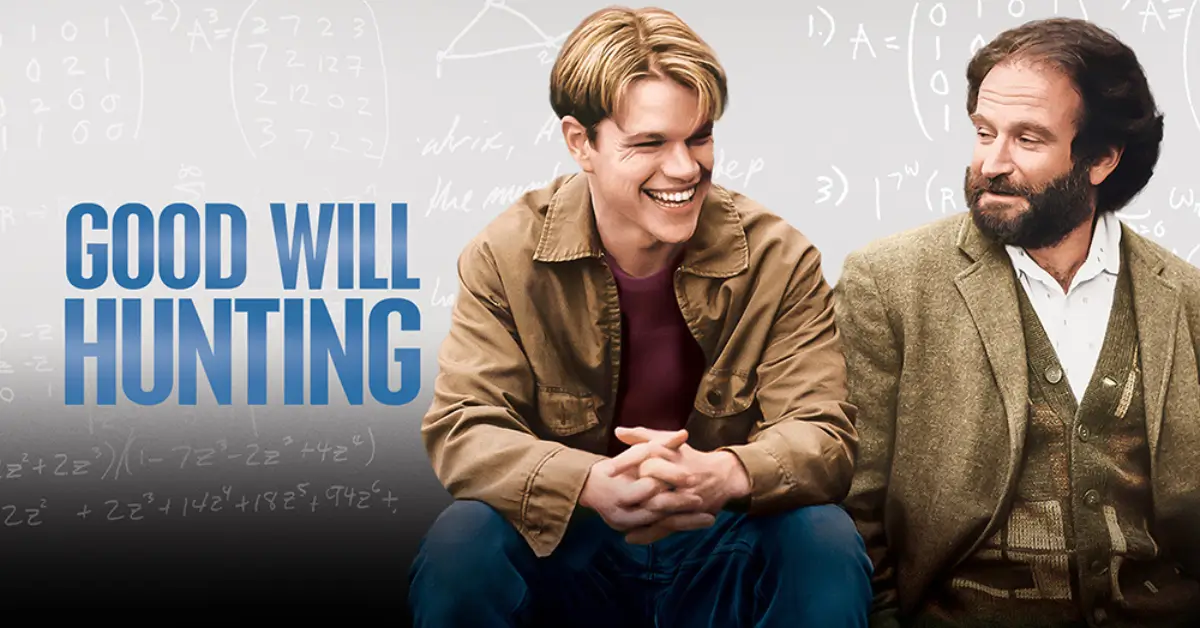Good Will Hunting: When Genius Meets Mental Health on Screen
In the realm of films that tackle mental health with nuance and authenticity, “Good Will Hunting” stands as a masterclass in storytelling that balances intellectual brilliance with emotional trauma. This 1997 drama not only launched the careers of Matt Damon and Ben Affleck as screenwriters but also created one of cinema’s most compelling portrayals of how childhood trauma shapes adult psychology and the transformative power of therapeutic relationships. The film invites viewers into the complex mind of a mathematical prodigy whose intellectual gifts are matched only by his emotional wounds, raising profound questions about human potential, vulnerability, and healing.
Thank you for reading this post, don't forget to subscribe!Basic Film Information
Title: Good Will Hunting
Release Date & Production Year: December 5, 1997 (limited); January 9, 1998 (wide release)
Director: Gus Van Sant (known for his sensitive portrayals of outsiders and independent filmmaking style)
Screenwriters: Matt Damon and Ben Affleck (their breakthrough screenplay, drawing partly from their Boston upbringing)
Main Cast & Characters:
- Matt Damon as Will Hunting (janitor and mathematical genius with a troubled past)
- Robin Williams as Dr. Sean Maguire (psychologist and community college professor)
- Ben Affleck as Chuckie Sullivan (Will’s best friend)
- Stellan Skarsgård as Professor Gerald Lambeau (Fields Medal-winning mathematician)
- Minnie Driver as Skylar (Harvard medical student and Will’s love interest)
Genre: Drama/Psychological Drama
Awards: Academy Awards for Best Supporting Actor (Robin Williams) and Best Original Screenplay (Matt Damon and Ben Affleck); nominations for Best Picture, Best Director, Best Actor, Best Supporting Actress, Best Film Editing, Best Original Score, and Best Song
Runtime & Rating: 126 minutes, R (for strong language, including sexual references)
Plot Summary
General Overview
“Good Will Hunting” follows Will Hunting, a 20-year-old janitor at MIT with extraordinary mathematical abilities who solves complex problems anonymously. When Professor Lambeau discovers Will’s talent, he offers him a chance to avoid jail time for assault by studying mathematics under his guidance and attending therapy sessions. Through these sessions with psychologist Sean Maguire, Will begins to confront his traumatic past and the emotional barriers he’s built to protect himself.
Mental Health Themes
The film explores multiple mental health issues including:
- Post-traumatic stress from childhood abuse and abandonment
- Attachment disorders and fear of intimacy
- Defense mechanisms (particularly intellectualization and pushing people away)
- Depression and self-sabotage
- The impact of social class and environment on psychological development
Key Turning Points
Several pivotal moments highlight Will’s mental health journey. The “breakthrough” scene where Sean repeatedly tells Will “It’s not your fault” represents a powerful catharsis as Will finally begins to release his self-blame for childhood abuse. Another crucial moment comes when Chuckie tells Will that the worst thing he could do is waste his potential by staying in their neighborhood. Will’s rejection of Skylar when she asks him to come to California represents his fear of vulnerability and connection, while his final decision to “go see about a girl” marks his embrace of emotional risk.
Ending Analysis
The film concludes with Will choosing to follow his heart rather than a predetermined career path, suggesting that emotional health and authentic relationships matter more than academic achievement. The open-ended finale showing Will driving toward an uncertain future implies that healing is a journey rather than a destination. This ambiguity offers hope while acknowledging that recovery from trauma is ongoing work.
Setting & Cinematic Techniques
Filming Locations
Set in Boston, Massachusetts, the film contrasts the elite academic world of MIT and Harvard with the working-class neighborhood of South Boston (“Southie”). This geographical division serves as a visual metaphor for Will’s psychological compartmentalization. Key locations include the university halls where Will works as a janitor, the neighborhood bar where he socializes, and Sean’s modest waterfront home where crucial therapy sessions occur.
Cinematography
Cinematographer Jean-Yves Escoffier employs visual techniques that reinforce the film’s psychological themes. Tight framing during therapy sessions creates intimacy and tension, while wider shots of Boston’s academic institutions emphasize Will’s status as an outsider. The warm, golden lighting in Sean’s office contrasts with the cooler, institutional blues of MIT, subtly underscoring the different approaches to knowledge and healing.
Sound & Music
Elliott Smith’s haunting folk songs provide an emotional counterpoint to Danny Elfman’s orchestral score. The music often serves as a window into Will’s internal world, particularly in moments when he cannot verbalize his feelings. The recurring theme “Miss Misery” accompanies Will’s most vulnerable moments, creating emotional resonance that deepens our understanding of his psychological state.
Acting & Character Portrayal
Lead Actor’s Performance
Matt Damon delivers a breakthrough performance as Will Hunting, masterfully balancing intellectual arrogance with profound vulnerability. Damon portrays Will’s defense mechanisms with subtle physical cues his posture stiffens during emotional conversations, his speech patterns become more aggressive when he feels threatened, and his eyes reveal his trauma even when his words are designed to push people away. Most impressively, Damon makes Will’s mathematical genius believable while ensuring his emotional struggles remain relatable.
Supporting Cast
Robin Williams’ Oscar-winning performance as Sean Maguire provides the emotional anchor of the film. Williams brings depth to a character who has experienced his own grief yet maintains compassion and professional boundaries. His portrayal of a therapist feels authentic showing how effective therapy involves strategic self-disclosure and genuine human connection rather than clinical detachment.
Minnie Driver’s Skylar and Ben Affleck’s Chuckie represent different aspects of Will’s potential futures. Stellan Skarsgård’s Professor Lambeau embodies the pursuit of intellectual achievement without emotional intelligence, serving as a counterpoint to Williams’ more integrated approach to human development.
Accuracy & Authenticity
The film’s portrayal of therapy departs from clinical reality in some ways progress happens more quickly than typical real-world treatment, and some therapeutic techniques are dramatized for emotional impact. However, the core therapeutic principles ring true: the importance of trust in the therapeutic relationship, the need to confront past trauma, and the role of empathy in healing. The film accurately depicts how defense mechanisms like intellect and humor can serve as shields against emotional pain.
Mental Health Representation: Strengths & Weaknesses
Psychological Accuracy
“Good Will Hunting” excels in depicting the lasting impact of childhood trauma on adult relationships and self-concept. Will’s difficulty with trust, his sabotage of potential success, and his pushing away of those who care about him are realistic manifestations of attachment issues resulting from abuse and abandonment. Sean’s explanation of defense mechanisms and the gradual building of therapeutic alliance reflect actual clinical concepts.
The film also accurately portrays how intelligence can become a defense mechanism, with Will using his intellectual gifts to intimidate others before they can hurt him. The script avoids simplistic psychological explanations, instead showing how family dynamics, social class, and personal history interact to shape mental health.
Stigmatization vs. Awareness
The film helps destigmatize therapy by portraying it as a strength rather than a weakness. Sean is presented as a capable therapist who has also sought help himself, normalizing the idea that everyone can benefit from psychological support. By presenting Will’s genius and his trauma as interconnected rather than separate aspects of his character, the film avoids the problematic trope of mental illness as the price of exceptional ability.
However, the film occasionally reinforces the misleading notion that a single breakthrough moment can resolve complex trauma. The relatively rapid pace of Will’s progress might create unrealistic expectations about the therapeutic process.
Impact on Public Perception
“Good Will Hunting” helped change public perception of therapy by presenting it as a form of courageous self-discovery rather than a clinical intervention. Sean’s humanistic approach contrasts with the more traditional therapy Will initially rejects, suggesting that effective mental health care adapts to the individual rather than following rigid protocols. The film’s commercial and critical success brought discussions about trauma, defense mechanisms, and therapeutic relationships into mainstream conversation.
Critical Reception & Awards
Critics’ Reviews
Critics widely praised the film for its emotionally resonant storytelling and authentic performances. Roger Ebert awarded it four stars, writing that it “has the courage to be about something real and true.” Janet Maslin of The New York Times called it “fresh and coherent, with characters full of real feeling.” Mental health professionals generally responded positively to the portrayal of therapy, though some noted that the treatment timeline was compressed for dramatic purposes.
Audience Reactions
The film resonated deeply with audiences, particularly those who had experienced trauma or undergone therapy. Many viewers with mental health challenges reported feeling seen and understood by the film’s nuanced portrayal of emotional struggles. The famous “It’s not your fault” scene has been cited by real-life therapy clients as a powerful representation of breakthrough moments in their own treatment.
Awards & Nominations
Beyond Williams’ Oscar for Best Supporting Actor and Damon and Affleck’s win for Best Original Screenplay, the film received universal acclaim for its sensitive handling of difficult psychological material. Its nine Oscar nominations and commercial success demonstrated that films addressing mental health with depth and authenticity could achieve both critical and popular recognition.
Cultural & Social Impact
Discussions Sparked
“Good Will Hunting” generated significant public conversation about childhood trauma, the purpose of therapy, and the relationship between intellectual and emotional intelligence. The film challenged the stigma surrounding mental health treatment, particularly for men, who traditionally faced greater social barriers to seeking help.
Influence on Other Films
The film established a template for psychological dramas that balance clinical accuracy with emotional resonance. Its success paved the way for other films that treat mental health with nuance, such as “Silver Linings Playbook” and “A Beautiful Mind.” Its portrayal of a therapeutic relationship as transformative rather than merely clinical influenced how subsequent films approach mental health narratives.
Mental Health Advocacy
While not explicitly created as an advocacy film, “Good Will Hunting” contributed to the normalization of therapy and psychological healing. Mental health organizations have used the film in educational contexts to illustrate how trauma affects development and how therapeutic relationships can facilitate healing. The film’s portrayal of a working-class man benefiting from therapy helped challenge the perception that mental health care is only relevant to privileged populations.
Personal Reflection & Final Thoughts
“Good Will Hunting” provides profound insights into how early attachment wounds shape adult behavior and how meaningful connections can heal even deep-seated trauma. The film’s greatest strength lies in showing that intellectual brilliance cannot compensate for emotional wounds true growth requires vulnerability and connection.
For those struggling with mental health issues, particularly trauma survivors, the film offers hope without minimizing the difficulty of the healing process. It validates the experience of using intelligence as a shield while suggesting that authentic connection offers something more valuable than intellectual achievement alone.
What could have been improved is the film’s compressed timeline of therapeutic progress. Real trauma work typically requires longer treatment than depicted, and breakthroughs usually come incrementally rather than in single cathartic moments. A more realistic portrayal might have shown Will’s healing as an ongoing process with both progress and setbacks.
Conclusion
“Good Will Hunting” remains a landmark film in mental health portrayal, offering a compassionate and nuanced depiction of how childhood trauma shapes adult psychology and how therapeutic relationships can facilitate healing. Through Will Hunting’s journey, viewers witness the courage required to confront painful memories and the transformative power of authentic human connection.
The film’s enduring legacy lies in its ability to make psychological concepts accessible without oversimplification. By balancing clinical insights with emotional truth, it created a narrative that resonates with both mental health professionals and those with lived experience of trauma and recovery. More than two decades after its release, “Good Will Hunting” continues to remind us that our deepest wounds often hold the key to our greatest growth if we have the courage to face them with the help of those who see our full humanity.
What are your thoughts on this film’s portrayal of therapy and trauma recovery? Does Will’s journey reflect the complex reality of healing from childhood wounds, or does the film simplify the therapeutic process for dramatic effect?

